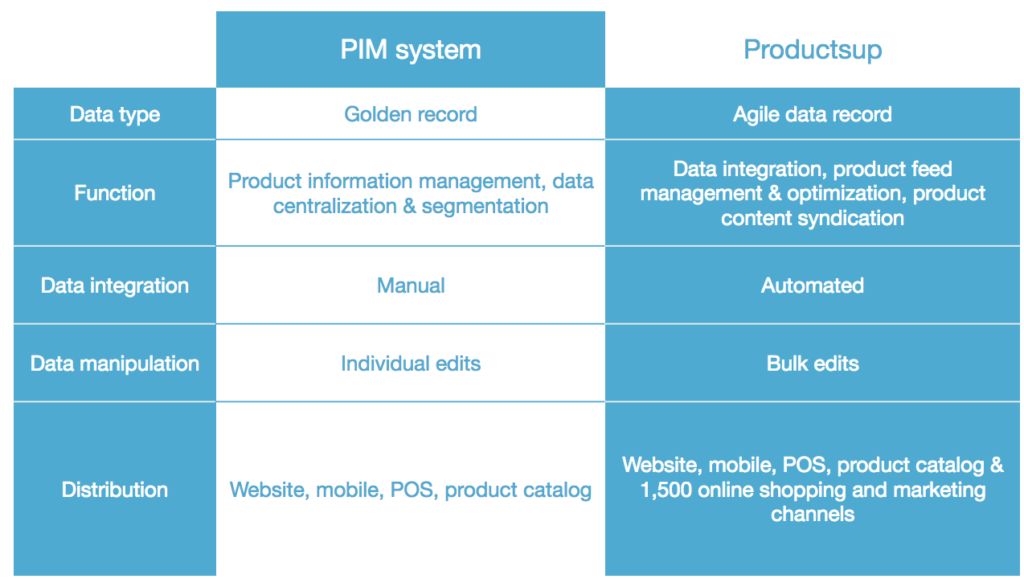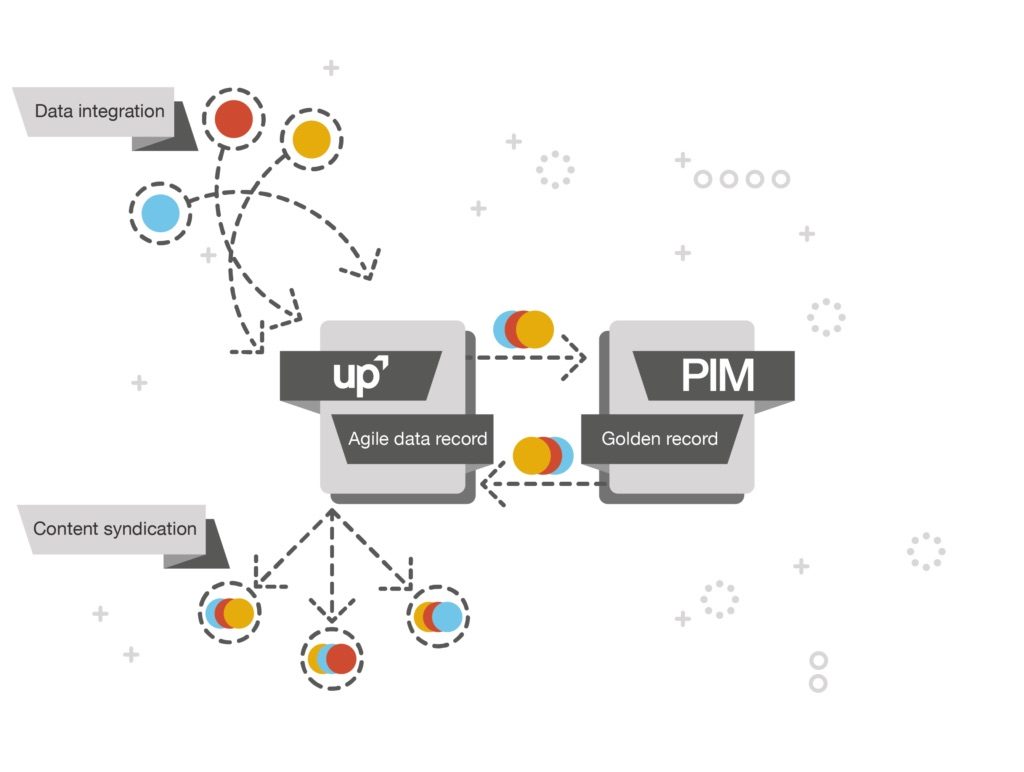Both commerce and ecommerce are like an iceberg, with a majority of their substance not visible from the surface. However, once you dive a bit deeper, you realize that there is much more to these industries than meets the eye. Under the surface of each, you’ll find a host of systems and software with strange acronyms like MDM, DAM, ERP, and PIM. And then there’s Productsup.
It’s the latter two, PIM and Productsup, that are often and easily confused with one another. However, they do not serve the same purpose. Instead, both carry an important piece to the product content puzzle, which keeps the iceberg afloat.
What does this all mean? To put it simply, Productsup is not a PIM system. But the two work closely together. While both PIM and Productsup both focus heavily on product data - and lots of it - their functionality and what they allow you to do with this data are completely different. In order to truly excel in the commerce space, it’s important to not only tell them apart but also to understand how using them together can drive your business.
Before we get into how the two differ and how they work together, we’ll first need to define them individually and establish the purpose of each.
Ready to explore? Then put on your diving gear and let’s go!
What is a PIM system?
Product information management systems (PIMs) were developed back in the early 90s when the internet was quickly becoming essential to everyday life. Back then, companies dealing with mass quantities of product information had no easy way of centralizing and maintaining it. This often resulted in internal departments of the same company referring to completely different databases, thus accessing inconsistent product information. Companies were in need of a central repository for product information.
PIM systems were created as a solution, allowing for consistent, centralized, and single-formatted, raw product information across the board. This product information could then be used for both online and offline purposes, including websites, product catalogs, mobile, and Point of Sale. Due to the variety of product information and uses for the data held in a PIM, it can be referred to as the “golden record” of your product data.
What is Productsup?
Productsup is a cloud platform for enterprise companies looking to increase the agility of their product data. Essentially, the software is a one-stop-shop for brands and manufacturers, retailers, or anyone with a large inventory (up to millions!) of physical or service products. Using the software, they can collect, revise, transform, and transfer product content from anywhere to anywhere.
Complete with drag-and-drop functionality, Productsup requires no code. Product data is edited in bulk, according to the specs of preconfigured or custom export channel templates. Product feeds are customized for thousands of destinations, be it for online shops or brick and mortar stores, marketplaces and comparison shopping sites, or retargeting and affiliate engines.
With product data integration, feed management, and content syndication, at Productsup’s core, product data is constantly changing and adapting to each individual channel’s requirements. This ensures that rich, complete and correct product data is distributed to wherever it needs to go. Therefore, the product data held within Productsup can be referred to as an “agile data record”.
Differences between Productsup and PIMs
Now that we’ve defined both Productsup and PIMs, it may be a bit easier to see where the two differ. But just so we are all on the same page, let’s focus on examining some of the key differences. See the chart below for an overview:

How do they work together?
PIM systems are strong in their ability to centralize and manage high volumes of product information. They are also extremely useful in ensuring the consistency of product information across departments (i.e. the finance department has the same information as the marketing team). As you can see in the graph above, what’s in your PIM will reflect on your website, your Point of Sale and your product catalogs. This means that, in order for your PIM to provide the most value, you need to ensure that the product information is complete, correct, updated, structured, and standardized. However, a brand manufacturer or retailer gathers product information from a number of different suppliers and vendors. This can range from other branded products (for resell) to your own brand’s product reviews, images or performance data. Every supplier of product data uses their own terms and structures, and the quality of data is out of your control.
How is it possible for you to maintain a healthy PIM system? The challenge is, most PIMs don’t allow for bulk data changes, so your products need to be reviewed and edited manually, one-by-one. With a product inventory in the thousands or more, this is not feasible. Alternatively, you can have just one structured and reliable data import containing all your products and their relevant information. Wait, what? Is that possible? With Productsup, it is!
-
Product content integration (using Productsup before product content is in PIM)
Productsup can merge all of your product information from different suppliers, allowing you to easily and efficiently structure and clean your data in bulk, all before it even enters your PIM system. Doing this guarantees consistent product information across the board, including for your website, mobile POS, and product catalog (for which data is taken directly from PIM).
But the PIM and Productsup companionship doesn’t end with data structuring and integration.
-
Feed management & product content syndication (using Productsup after product content is in PIM)
On the other end of the spectrum, Productsup allows PIM users to create enriched and customized product feeds for over 1,500 retailers, marketplaces, and marketing channels. Since PIM systems essentially are a repository of product information, data stored is simply not agile enough for omnichannel product content syndication. Productsup makes this possible.
Users can optimize their product feeds in bulk using a number of powerful features, tools, and services built into the software, including smart machine learning technology to automate most of your work. From image optimization with the Productsup Image Designer and preconfigured export templates to drag-and-drop data editing technology and bulk transformations, Productsup makes any data agile and high-quality enough to fit any destination.
A lot of information, right? Here is a graphic that highlights the relationship between Productsup and PIM systems:

Productsup is the ideal companion to PIM systems. Here is an example of how the platform has partnered with SAP Hybris.
Productsup and SAP Hybris PCM

Productsup Data Syndication 1.2 is one of the first products to achieve SAP premium certification for integration with SAP applications. This elite certification proves that the technical integration of Productsup data syndication 1.2 has met the high-quality standards set by SAP. For SAP Hybris customers, this integration enables automated, streamlined product content syndication.
For more information about the key features, benefits, and target industry, see Productsup’s listing in the SAP App Center or visit the SAP Certified Solutions Directory.
Who is your PIM provider? Whoever you choose, Productsup can help you and your product data. We work closely with several popular PIM providers, from SAP and Akeneo to Riversand and Pimcore, to ensure the best customer experience. We work hard to make the process easy, so you can be sure you're getting the most out of your PIM system.
Sum up
In a nutshell, Productsup and PIMs are the perfect companions. When in doubt, remember these key takeaways:
- __Productsup before PIM__: Merge, structure, and standardize your product information before it even gets to PIM to make sure it's consistent
- __Productsup after PIM__: Customize, optimize, and ensure channel readiness for product content syndication
- __PIM__: Golden record containing all product information
- __Productsup__: Agile data record containing all product feeds and flexible product datasets for syndication

![[WP Import] Productsup & PIM systems: companions, not competitors](http://images.ctfassets.net/q17uls4wkkdz/2vhguszGKJj9s5pFas9wmT/81150b8da20281565ec9d610b799a25d/puppim_feature_image.jpg?w=1200&h=675&fit=FILL)